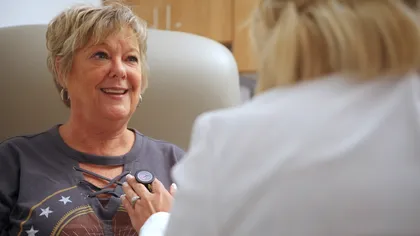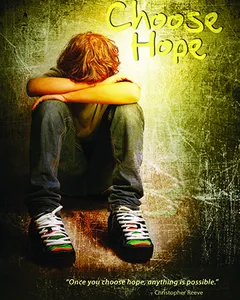What concerns local teens the most? Many would assume that drugs and alcohol, bullying, or body image would top the list. In fact, according to the 3,159 students polled by the Illinois Youth Survey (IYS), depression and suicide are now the biggest concerns for eighth grade students in a seven-county area. In all, 38 percent of eighth-graders surveyed listed depression or suicide as their top health concern for people their age.
Sarah Bush Lincoln Child Psychiatrist Katie Hecksel, MD, explains, “Adolescents and teenagers developmentally have a difficult time seeing beyond an immediate stressor or tolerating strong emotions without acting on them,” she added, “This makes them more susceptible to act on suicidal thoughts, particularly when encouraged by others.”
In an effort to help people learn more about teenage depression and suicide, Sarah Bush Lincoln is teaming with WEIU-TV to present a live broadcast entitled “Choose Hope.” The program airs at 7 pm, Tuesday, Sept. 12 on WEIU-TV throughout the region. Sarah Bush Lincoln experts Child Psychiatrist Katie Hecksel, MD, and Pediatrician David Stoltz, MD, will answer call-in and email questions throughout the program.
Jeremie Smith, Mattoon Middle School principal said that the results of the Illinois Youth Survey are not surprising. “The concern is legitimate,” Smith said, “We are seeing a distinct increase in the number of students using mental health services because of behavioral, social, emotional, even physical issues having to do with depression.”
According to Smith, many instances of teen depression are beyond the repair of the schools. With a limited number of staff trained to deal with such emotional issues, he said the effort to assist these teens can feel like “putting a Band-Aid on a chainsaw wound.” Smith said there are several factors that can cause a teen to feel depressed, but he attributes the results of the survey to one primary source: social media.
Dr. Hecksel said there is data to support Smith’s opinion. Medical studies have indicated that victims of cyberbullying are twice as likely to attempt suicide than students who are not experiencing bullying. Interestingly, cyberbullies themselves were 1.5 times more likely to have attempted suicide than children who were neither cyberbullying offenders, nor victims. According to Dr. Hecksel, this would suggest that there could be significant public health benefit in providing mental health interventions for both those getting cyberbullied, as well as those doing the cyberbullying.
“Social media unfortunately gives bullies a safety net to hide behind, the ability to pose as others, be anonymous, or say and do things they would never do if forced to confront someone in person,” Dr. Hecksel said.
Smith echoes Dr. Hecksel’s opinion. “Computers and phones give students a force-field to hide behind,” he added, “It removes the filter that teens have when they speak face-to-face. They don’t have a sense of accountability, or of the impact that their words and actions are having on the person on the other end of the computer.”
A recent nation-wide rash of live-streamed suicides on social media is also cause for great concern among parents and educators. Smith said that he sees today’s teens struggling to form genuine relationships because of the amount of time they spend behind screens.
“Many of today’s teen relationships are already superficial and temporary,” Smith said, “If you throw a bully or a broken heart into the mix, it can leave them feeling alone and helpless because they don’t really know how to connect with someone who can help. I think they make live videos because they are hoping that some compassionate soul will see it and reach out to help them.”
Dr. Hecksel explained, “The rise in websites, television shows, internet videos and chat rooms promoting and detailing suicide are particularly risky for youth who are already depressed and vulnerable,” she added, “These provide a community of seemingly like-minded people who support the adolescent’s feelings of hopelessness, while making it seem that the only successful solution is suicide.”
Dr. Hecksel and Smith have suggestions for parents and guardians living with teens:
• Be aware of your teen’s mood changes. While many teens are at least minutely combative, if you find your teen in a constant state of agitation, or if they become angry at even the simplest requests, seek help from a counselor or physician.
• Limit time on devices. Parents are encouraged to keep phones away from the dinner table in order to encourage face-to-face conversation. Keep teens’ cell phones out of their bedroom at night and instead, charge them in a kitchen or family room.
• Set the notifications and privacy settings on your teen’s phone. Check your teen’s devices regularly for inappropriate content or dual accounts. “I see teens with three or four social media accounts that they hide from their parents,” Smith said.
• Spend time together. If you notice your teen is in a constant state of withdrawal or is no longer interested in the activities they once enjoyed, seek help.
• Monitor your teen’s circle of friends. Talk to all of the parents involved before sending teens to parties, sleepovers, and trips. “Many parents are worried that their teen will become angry if the parent checks up on them,” Smith said, “It’s important for parents to remember that their primary charge is not to be their child’s best friend, but to keep them safe and healthy.”
To submit your questions to be answered on the air, please email them to weiu@weiu.net, or phone them in during the show at 1-877-727-9348.










